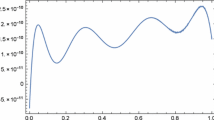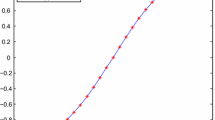Abstract
In this paper, a numerical method to solve non-linear integral equations based on a successive approximation technique is considered. A sequence of functions is produced which converges to the solution. The process includes a fixed point method, a quadrature rule, and an interpolation method. To find a total bound of the error, we investigate error bounds for each approximation and by combining them, we will derive an estimate for the total error. The accuracy and efficiency of the method is illustrated in some numerical examples.
Similar content being viewed by others
Notes
For h = f and w = v we write T 0 x shortly for T 0(f, v, x).
Note that in computations the evaluation of \(\|g-I_{\Delta }g\|_{C^{0}(\tau )}\), typically, has to be replaced by the maximum over |(g−I Δ g)(t τ, i )| for a finite set {t τ, i :1≤i ≤ n τ }⊂τ.
From (57) it follows that
$$\frac{h_{\ell}}{h_{\ell-1}}=\frac{h_{\tau_{\ell+1}}+h_{\tau_{\ell}}}{h_{\tau_{\ell-1}}+h_{\tau_{\ell}}}\leq\frac{1+\kappa}{1+\frac{1}{\kappa}}=\kappa. $$
References
Agarwal, R.P., O’Regan, D., Wong, P.J.Y.: Positive Solutions of Differential, Difference and Integral Equations. Kluwer Academic, Dordrecht (1999)
Appell, J., Zabrejko, P.P.: Nonlinear Superposition Operators. Cambridge Tracts in Mathematics, vol. 95. Cambridge University Press, Cambridge (1990)
Banaś, J., Goebel, K.: Measures of Noncompactness in Banach Spaces, vol. 60. Marcel Dekker, New York (1980)
Banaś, J., Martinon, A.: Monotone solutions of a quadratic integral equation of Volterra type. Comput. Math. Appl. 47, 271–279 (2004)
Banaś, J., Olszowy, L.: Measures of noncompactness related to monotonicity. Comment. Math. 41, 13–23 (2001)
Banaś, J., Rzepka, B.: On existence and asymptotic stability of solutions of a nonlinear integral equation. J. Math. Anal. Appl. 284, 165–173 (2003)
Banaś, J., Sadarangani, K.: Monotonicity properties of the superposition operator and their applications. J. Math. Anal. Appl. 340, 1385–1394 (2008)
Burden, R.L., Faires, J.D.: Numerical Analysis, 8th edition. Cengage learning (2005)
Burton, T.A.: Volterra Integral and Differential Equations. Academic Press, New York (1983)
Carey, G.F., Dinh, H.T.: Grading functions and mesh redistribution. SIAM J. Numer. Anal. 22, 1028–1040 (1985)
Deimling, K.: Nonlinear Functional Analysis. Springer-Verlag, Berlin (1985)
Kershaw, D: A note on the convergence of interpolatory cubic splines. SIAM J. Numer. Anal. 8, 67–74 (1971)
Maleknejad, K., Nouri, K., Mollapourasl, R.: Existence of solutions for some nonlinear integral equations. Commun. Nonlinear Sci. Numer. Simul. 14, 2559–2564 (2009)
Maleknejad, K., Nouri, K., Mollapourasl, R.: Investigation on the existence of solutions for some nonlinear functional-integral equations. Nonlinear Anal. 71, 1575–1578 (2009)
Maleknejad, K., Mollapourasl, R., Nouri, K.: Study on existence of solutions for some nonlinear functional-integral equations. Nonlinear Anal. 69, 2582–2588 (2008)
Maleknejad, K., Torabi, P., Mollapourasl, R.: Fixed point method for solving nonlinear quadratic Volterra integral equations. Comput. Math. Appl. 62, 2555–2566 (2011)
Mathews, J.H., Fink, K.D.: Numerical Methods Using Matlab, 4th edition. Prentice-Hall Inc, New Jersey (2004)
O’Regan, D., Meehan, M.: Existence Theory for Nonlinear Integral and Integro-Differential Equations. Kluwer Academic, Dordrecht (1998)
Stoer, J., Bulirsch, R.: Introduction to Numerical Analysis, 3rd edition. Springer-Verlag, New York (2002)
Author information
Authors and Affiliations
Corresponding author
Additional information
Dedicated to Professor Eberhard Zeidler on the occasion of his 75th birthday.
Appendix: Stability and Convergence of Cubic Spline Interpolation
Appendix: Stability and Convergence of Cubic Spline Interpolation
Theorem 11
For an interval partitioning
with corresponding function values \(\mathbf {f}:=(f_{i})_{i=0}^{N}\), let u Δ denote the cubic interpolating spline with boundary conditions
-
a.
Then
$$ \left\|u_{\Delta}\right\|_{C_{0}(I) }\leq C\|\mathbf{f}\|_{\max}, $$(55)where C depends on the global quasi-uniformity h/h min with h min := min{h τ : τ ∈ Δ}. Let f ∈ C ℓ(I) for some 0 ≤ ℓ ≤ 4. Then
$$ \|f-u_{\Delta}\| \leq Ch^{\ell}\left\|f^{(\ell)}\right\|. $$(56) -
b.
Let the constant of local quasi-uniformity be given by
$$ \kappa:=\max_{1\leq i\leq N-1}\left\{\max\left\{\frac{h_{\tau_{i}}}{h_{\tau_{i+1}}},\frac{h_{\tau_{i+1}}}{h_{\tau_{i}}}\right\}\right\} $$(57)and assume κ 2 <2. Then
$$ \left\| u_{\Delta}\right\|_{C^{0}(I)}\leq C_{\Delta}\|\mathbf{f}\|_{\max}\quad\text{ with }~C_{\Delta}\leq\frac{C}{2-\kappa^{2}}, $$(58)where C only depends on κ. Let f ∈ C ℓ(I) for some 0 ≤ ℓ ≤ 4. Then
$$ \left\| f-u_{\Delta}\right\| \leq\frac{C}{2-\kappa^{2}}h^{\ell}\left\|f^{(\ell)}\right\|. $$(59)
Proof
For \(k,p\in \mathbb {N}_{0}\), let
For simplicity, we assume that N ≥ 4. We construct a function u aux ∈ S 4,9 such that
where, for 0 ≤ i ≤ N and 0 ≤ k ≤ 4, the values f i, k are divided differences
which are centered at
As usual for Hermite interpolation, we initialize the divided differences by
and employ for the remaining differences the recursion
for m ≥ 1 and n ≥ 1. On an interval τ = [t i−1, t i ], this leads to
where, for 0 ≤ k ≤ 4,
Thus, we get for 0 ≤ m ≤ 4
We introduce the index neighborhood (cf. (60))
which contains those indices which are involved in the definition of \(\left [ \underset {m\text {-times}}{\underbrace {t_{i-1},\ldots t_{i-1}}},\underset {n\text {-times}}{\underbrace {t_{i},\ldots ,t_{i}}}\right ] f\) for 0 ≤ m ≤ 4, 0 ≤ n ≤ 4 with (m, n)≠(0,0). We set
and obtain
Thus, for 0 ≤ r ≤ m ≤ 4, it holds
where C 3 only depends on the local quasi uniformity, i.e., on κ. This leads to
Proof of Case a. We employ [12,Theorem 2] and (61) to obtain
To prove (56), we assume f ∈ C ℓ(I) for some 0 ≤ ℓ ≤ 4. Then, well known properties of divided differences imply
and similarly as in (62) we get
where C depends on the global shape regularity h/h min.
Proof of Case b. From [12]Corollary, we conclude that on an interval τ = [t i−1, t i ] it holds
The first term in the right-hand side of (64) can be estimated by using (61) with m = 4
where C 4, again, only depends on the local quasi uniformity, i.e., on κ. Let ℓ∈{1,…,N−1} be such that
with
Then, according to [12](2), the differences \(d_{i}^{(2)}\) satisfy the relation
with \(\alpha _{\ell }=\frac {h_{\tau _{\ell }}}{h_{\tau _{\ell }}+h_{\tau _{\ell +1}}}\) and
Multiplying (66) by \(h_{\ell }^{2}\) leads toFootnote 4
Hence
From [12](2), we conclude that
with
Thus, the second term in (64) can be estimated by
and (58) follows.
To prove (59), we assume f ∈ C ℓ(I) for some 0 ≤ ℓ ≤ 4 and estimate next the first term in the right-hand side in (65) by using (61)
For the second term in (64), we first observe that
holds so that the second term in (64) can be estimated by
where C only depends on the local quasi-uniformity of the mesh and (58) follows. □
Rights and permissions
About this article
Cite this article
Maleknejad, K., Torabi, P. & Sauter, S. Numerical Solution of a Non-Linear Volterra Integral Equation. Vietnam J. Math. 44, 5–28 (2016). https://doi.org/10.1007/s10013-015-0149-8
Received:
Accepted:
Published:
Issue Date:
DOI: https://doi.org/10.1007/s10013-015-0149-8
Keywords
- Nonlinear quadratic Volterra integral equation
- Fixed point theorem
- Measure of noncompactness
- Fixed point method
- Adaptive quadrature
- Nonuniform interpolation nodes




